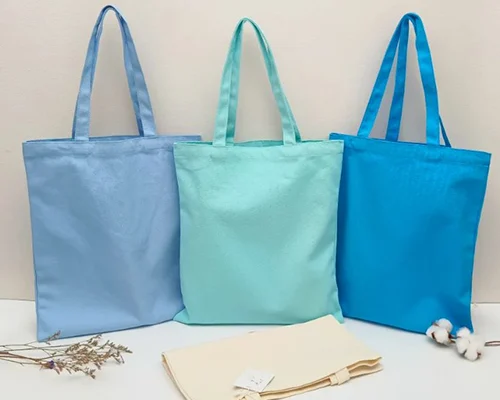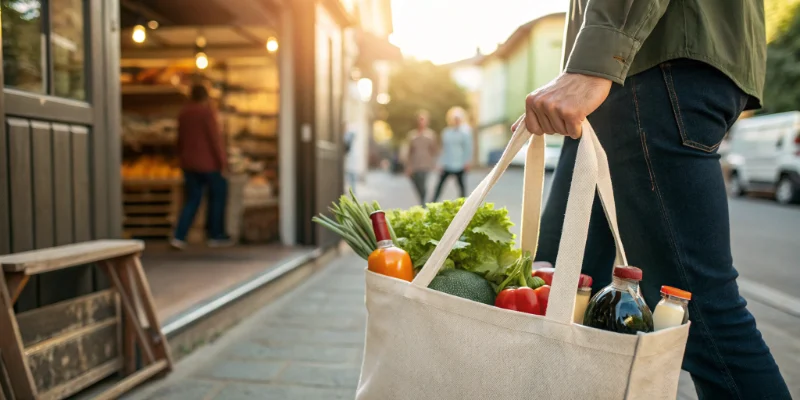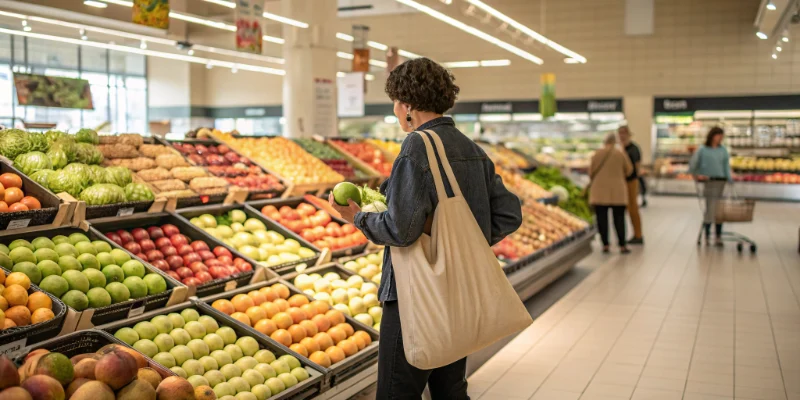
Tote bags have become a common sight in shopping, commuting, and everyday life. Their simple design and spacious capacity make them both practical and stylish, while also aligning with eco-friendly values. However, before choosing one, many people wonder: what are the real pros and cons of tote bags? This article will walk you through their main advantages and drawbacks, helping you decide whether a tote bag truly fits your lifestyle.
Tote bags have large capacity and a simple structure, making them suitable for many occasions. Whether for daily shopping, commuting to work, or short weekend trips, they can easily handle the task. Their spacious interior and open-top design make them a versatile storage tool in daily life. Compared with other types of bags, they have almost no usage limits, truly achieving “one bag for many uses.”
Common tote bag materials such as canvas, cotton, and woven polypropylene (PP) are highly resistant to wear and very durable. Even with frequent heavy use, they are not easily damaged. Their long lifespan greatly reduces replacement frequency and improves overall cost-effectiveness. In scenarios where heavy items need to be carried, such as books, groceries, or office supplies, tote bags are fully capable.
Tote bags can be made from a wide variety of materials, including cotton, canvas, jute, non woven fabric, PP woven fabric, nylon, polyester, Tyvek, and washable kraft paper. Each material differs in texture, durability, appearance, and environmental performance, bringing diverse expressions and application scenarios to tote bags.
Tote bags cover a wide price range, from promotional bags costing only a few yuan to high-end custom models priced in the hundreds. Consumers can freely choose according to their budget, and businesses can control costs when purchasing in bulk. Their cost-effectiveness makes tote bags one of the most widely accepted bag types on the market. Whether for personal use or corporate events, it is easy to find the right option.
Tote bags usually come with two handles that allow for both hand-carrying and shoulder-carrying. The shoulder design frees the hands and offers greater convenience during shopping, commuting, or traveling. Some styles also feature extended or adjustable straps, improving comfort and adaptability. This flexibility makes tote bags more user-friendly for daily outings.
Most tote bags have an open-top structure that allows users to quickly place or retrieve items. This is especially efficient when carrying laptops, folders, clothes, or groceries, as the wide opening reduces obstacles and speeds up access. Compared with bags that have more complex structures, tote bags save time when finding items.
With their simple design and large capacity, tote bags can be useful in many aspects of daily life. Whether for students, office workers, or homemakers, there is always a suitable way to use them. They are an essential item in modern life. Almost every household keeps several tote bags ready for use when needed.
The flat surface of tote bags provides a large printing area, making them ideal for corporate customization. Logos, slogans, or creative patterns can be clearly displayed. They are not only practical tools but also moving billboards that help increase brand exposure. For brands looking to enhance awareness, this is a low-cost yet effective promotional method.
Different tote bag materials have good cleaning properties. Cotton and canvas can be machine-washed; Tyvek, washable kraft paper, and non woven bags can be wiped clean with a damp cloth. This type of maintenance makes tote bags more suitable for frequent use. Keeping them clean not only extends their lifespan but also maintains their appearance over time.
Tote bags have a roomy interior that can hold large items such as laptops, clothes, and groceries all at once. For people who need to carry many belongings, tote bags are a better choice than ordinary handbags. They reduce the hassle of frequently changing bags and increase daily convenience.
At the end of their life cycle, most tote bag materials can be recycled, such as cotton, canvas, and linen, which can enter the textile recycling system. Even if recycling is not possible, they can be repurposed into storage bags, shopping cart liners, or DIY items, extending their usefulness and reducing waste. This cycle of reuse makes tote bags even more advantageous in terms of environmental performance.
Tote bags are suitable for carrying heavy items like books and groceries. True
Materials such as canvas, woven PP, and cotton are strong and durable, making tote bags reliable for heavy loads.
Tote bags always have multiple compartments for organization. False
Many tote bags have only one large compartment without dividers, which makes organizing small items more difficult.

Most tote bags have an open-top design, which makes items easily exposed, and in crowded places valuable belongings are at risk of falling out or being stolen. In addition, the lack of closures such as zippers or magnetic snaps further reduces the security of personal items, and for people who frequently use public transportation or walk through crowded areas, this drawback is especially obvious.
Tote bags usually only have one large space without dividers or pockets, so small items can easily get mixed together, making them inconvenient to access and poorly organized. This “one bag fits all” design often causes keys, earphones, or cards to sink to the bottom, increasing the time needed to find them, and even if some totes have inner pockets, they are often not enough to meet complex storage needs.
Most tote bags rely on one shoulder to bear the weight, and when items are heavy it easily causes uneven weight distribution, and long-term carrying can lead to discomfort or soreness in the shoulder. Thin straps tend to dig into the shoulder when bearing weight, making it more uncomfortable, and compared with backpacks that share the load across both shoulders, tote bags are clearly less ergonomic.
Tote bags have large capacity, but once they are filled the weight increases significantly, and overloading not only reduces carrying comfort but also accelerates the wear of straps and the bag itself. When too many items are loaded, the tote bag easily becomes deformed, which affects its appearance and speeds up the wear of seams and the bottom.
Choose tote bags with zippers, magnetic snaps, or drawstring closures to effectively prevent items from being exposed. For bags without closure designs, place valuables inside an additional zippered pouch for extra protection.
Use organizers or bag inserts to classify and store keys, cosmetics, and electronic products. This not only makes it quicker to find what you need but also prevents small items from piling up in a mess inside the bag.
Try to avoid carrying overly heavy loads for long periods, and if necessary, split the items into separate bags. Choose wide straps or add shoulder pads, and switch shoulders regularly to reduce localized pressure.
Opt for materials with waterproof coatings or linings, such as nylon, Tyvek, or laminated canvas, to improve protection. If the tote bag itself is not waterproof, use waterproof pouches or a rain cover for the bag when needed.
Control the amount of items you carry and avoid overloading just because the bag can hold more. When carrying many items is unavoidable, choose styles with reinforced bottoms or double-stitched seams to extend the bag’s lifespan.

Tote bags are widely used as promotional gifts by companies. True
The large flat surface of tote bags is ideal for printing logos or slogans, making them popular for branding and events.
Using tote bags can completely eliminate the need for backpacks. False
Tote bags are versatile, but backpacks distribute weight more evenly and are better for carrying heavy loads over long periods.
Backpacks distribute weight evenly across both shoulders, making them more suitable for carrying heavy loads for long periods. Tote bags, however, are lighter and more stylish, ideal for daily commuting and short trips. Their drawback is the single-shoulder design, which may cause discomfort over time.
The biggest advantage of tote bags is that they are reusable and eco-friendly, significantly reducing the pollution caused by single-use plastic bags. Although plastic bags are cheap and lightweight, their disposable nature brings great environmental harm, and they cannot match tote bags in durability or appearance.
Handbags usually emphasize delicate design and portability, making them suitable for formal or fashion occasions. Tote bags, on the other hand, have a larger capacity and wider uses, meeting needs such as shopping and commuting. However, handbags generally perform better in terms of security and compartmental organization.
| Comparison | Advantages of Tote Bags | Disadvantages of Tote Bags |
|---|---|---|
| Backpack | Lighter, more stylish, large capacity, suitable for commuting and shopping; more flexible with single-shoulder carry | Less balanced weight distribution than backpacks, may cause shoulder strain over time |
| Plastic Bag | Reusable, eco-friendly, durable, more attractive designs, customizable printing | Higher cost than disposable plastic bags, requires cleaning and maintenance |
| Handbag | Larger capacity, more versatile, suitable for shopping, commuting, and travel | Lacks compartments and closure, less secure, less refined appearance compared to handbags |
Tote bags are not a complete replacement for other bags but offer a multifunctional choice that combines capacity, eco-friendliness, and style. They are more eco-friendly than plastic bags, more practical than handbags, and lighter than backpacks, though they do fall short in terms of security and weight-bearing. For students, office workers, commuters, and eco-conscious consumers, tote bags are undoubtedly a convenient and valuable everyday companion. Businesses also often use them as ideal tools for brand promotion. However, if you need to carry heavy items for long periods or place great importance on security and compartmental storage, tote bags may not be the best fit. Overall, their advantages clearly outweigh their disadvantages, but whether they are worth choosing depends on your personal lifestyle and needs.
If you are looking for custom tote bags for shopping, commuting, or brand promotions, Yanxin Bag is a professional tote bag manufacturer that offers a wide range of solutions. We support various materials such as cotton, canvas, jute, non woven fabric, Tyvek, and washable kraft paper, along with multiple printing options including screen printing, heat transfer, and lamination, ensuring your custom tote bags are both practical and brand-driven.
Whether for corporate events, promotional giveaways, or wholesale retail, Yanxin Bag is a reliable tote bag factory you can trust. Contact us today to explore the best tote bag customization options for your business.
Looking for a complete guide to canvas tote bags?
This article introduces canvas tote bags in detail, explaining what they are, why they’ve become popular, and the benefits they bring. It also describes the main types of canvas totes, offers tips on how to choose the right one, and provides advice on care and maintenance.
Curious about the real strengths and weaknesses of canvas bags?
This article explains what canvas bags are, presenting their main benefits such as durability, eco-friendliness, and printability, while also pointing out drawbacks including heavier weight, fading, and water absorption.
Wondering whether canvas or leather fits your lifestyle better?
This article introduces canvas and leather bags, then compares them in terms of material, durability, weight, weather resistance, maintenance, style, and environmental impact, helping you choose the one that suits your needs.
Want to keep your canvas bags fresh and long-lasting?
This guide focuses on practical cleaning methods for canvas bags, explaining how to remove stains, which washing approaches work best, and how to maintain the bags in good condition for daily use.
Not sure which material makes the best reusable bag?
This article looks closely at different reusable bag materials, introducing their characteristics, common applications, and strengths and weaknesses, helping you compare and choose the material that best fits your needs.
Get a free quote and expert consultation today. Let's bring your brand vision to life.
1 Exploring this link will deepen your understanding of eco-friendly practices and their impact on sustainability.
2 Discover insights on how promotional items like tote bags can foster brand loyalty and goodwill among customers.
3 This resource will provide insights into how different materials affect the performance of tote bags, especially in wet conditions.
Answer: Tote bags are spacious, reusable, and eco-friendly. They offer multifunctionality for shopping, commuting, or travel, and come in diverse materials and styles to suit different needs.
Answer: Yes, tote bags are considered eco-friendly because they replace single-use plastic bags. Many are made from sustainable materials such as cotton, canvas, RPET, jute, or washable kraft paper.
Answer: Tote bags are generally very durable, especially those made from canvas, jute, or woven PP. They can withstand heavy use and last for years with proper care.
Answer: Many tote bags, such as cotton and canvas types, are machine-washable. Others, like jute or Tyvek bags, should be gently cleaned by hand to maintain their durability.
Answer: Tote bags can carry heavy items if made from strong materials like canvas or woven PP. However, overloading them may cause discomfort due to weight distribution on one shoulder.
Answer: No, tote bags have a timeless design that adapts to both casual and formal settings. Their simplicity and wide design options keep them fashionable across generations.
Answer: Popular materials include cotton, canvas, jute, polyester, RPET, Tyvek, and washable kraft paper. Each offers unique benefits such as durability, eco-friendliness, or water resistance.
Answer: Tote bags are practical, reusable, and appeal to a wide audience. They can be easily customized, making them ideal gifts for events, holidays, or corporate giveaways.
Answer: Yes, tote bags range from low-cost non-woven options for promotions to premium versions made from canvas, Tyvek, or leather. This makes them suitable for all budgets.

Order or no-order we are Always here to help you!
We will contact you within 1 working day, please pay attention to the email with the suffix “@yanxinbag.com”.
Order or no-order we are Always here to help you!
We will contact you within 1 working day, please pay attention to the email with the suffix “@yanxinbag.com”.